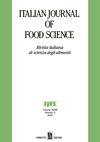调制果汁的抗血脂异常和抗高胆固醇血症作用:一项随机、双盲、安慰剂对照试验
IF 3.3
4区 农林科学
Q2 FOOD SCIENCE & TECHNOLOGY
引用次数: 0
摘要
在全球范围内,血脂异常是一种令人担忧的疾病,可能导致死亡。然而,其国家比例各不相同。在巴基斯坦,男性和女性的这一比例约为16-20%。血脂异常可以定义为血液中脂质含量高于平均值。血脂异常的治疗可以通过当地来源的饮食干预来完成。浓缩果汁具有降低低密度脂蛋白(LDL)、总胆固醇(TC)和甘油三酯(TG)的能力。并提高高密度脂蛋白(HDL)水平。对于疗效研究,在Sargodha的不同诊所和医院接触了血脂异常的女性(n=1010)。他们用生物标志物进行了研究,即血脂、TC、HDL、尿素、肌酐和TGs。共选择85名女性,将她们分为三组(T0、L1和M1)。T0是一个实验(对照)组,T1组有-名血脂异常患者用实验室制造的果汁治疗,M1有-名脂异常患者用市场产品治疗。治疗120天后,对数据进行统计学分析,以验证研究结果。由血脂异常的志愿者评估人体测量和饮食摄入量。在L1中发现了显著水平的血脂异常生物标志物。TC(216-184mg/dL)、TG(215.54-138.46mg/dL)和LDL(145.64-134.34mg/dL。其他呈下降趋势的参数包括尿素(12.73-11.15 mg/dL)、尿酸(6.12-5.38 mg/dL。基于这些结果,得出的结论是,实验室制造的混合物L1总体上显示出最佳的结果,也是合适的,并且具有成本效益,还需要进行大规模的进一步研究。本文章由计算机程序翻译,如有差异,请以英文原文为准。
Anti-dyslipidemic and anti-hypercholesteremic effects of concoction juice: A randomized, double-blind, placebo controlled trial
Globally, dyslipidemia is an alarming condition, which may cause death. However, its country-wise ratio varies. In Pakistan, it is about 16–20% in both men and women. Dyslipidemia can be defined as the up level quantity of lipids in blood than the average value. The treatment of dyslipidemia can be done by dietary interventions with indigenous sources. The (Concoction) juice has the ability to reduce the low-density lipoprotein (LDL), total cholesterol (TC), triglycerides (TGs). and raise the high-density lipoprotein (HDL) level. For efficacy studies, dyslipidemic females (n = 1010) were approached in different clinics and hospitals of Sargodha. They were approached with biomarkers, that is, lipidemic profile, TC, HDL, urea, creatinine, and TGs. A total of 85 females were selected and they were divided into three groups (T0, L1 and M1). T0 is an experimental (control) group, T1 group has -dyslipidemic patients treated with lab-made juice, and M1 has dyslipidemic patients treated with -market products. After 120 days of treatment, the data were analyzed statistically to validate the results of the study. The -anthropometric and dietary intake was assessed by dyslipidemic volunteers. A significant level of -dyslipidemic biomarker was found in L1. The down level was found in TC (216-184 mg/dL), TGs (215.54-138.46 mg/dL), and LDL (145.64-134.34 mg/dL), and raised level was found in HDL (44.15-54.43 mg/dL). Other parameters that showed a -downward trend were urea (12.73-11.15 mg/dL), uric acid (6.12-5.38 mg/dL), creatinine (1.02-1.0 mg/dL), ALT (55-34 u/l), AST (47-27 u/l), ALP (91.63-83.76 IU/L), bilirubin (0.65 to 0.57 mg/dl), RBCs, WBCs, and Hb. Based on these results, it is concluded that lab-made concoction L1 showed best results overall and is also appropriate and cost effective and further research has to be done on a large scale.
求助全文
通过发布文献求助,成功后即可免费获取论文全文。
去求助
来源期刊

Italian Journal of Food Science
工程技术-食品科技
CiteScore
4.20
自引率
0.00%
发文量
33
审稿时长
>36 weeks
期刊介绍:
"Italian Journal of Food Science" is an international journal publishing original, basic and applied papers, reviews, short communications, surveys and opinions on food science and technology with specific reference to the Mediterranean Region. Its expanded scope includes food production, food engineering, food management, food quality, shelf-life, consumer acceptance of foodstuffs, food safety and nutrition, energy and environmental aspects of food processing on the whole life cycle.
Reviews and surveys on specific topics relevant to the advance of the Mediterranean food industry are particularly welcome.
 求助内容:
求助内容: 应助结果提醒方式:
应助结果提醒方式:


